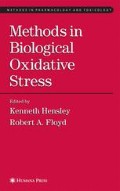Abstract
Oxidative stress may be a hallmark of several neurodegenerative disorders, including Alzheimer’s disease (AD), Huntington’s disease (HD), and Parkinson’s disease (PD), as well as Creutzfeldt-Jakob disease (CJD), frontotemporal dementia, and amyotrophic lateral sclerosis (ALS) (1). Oxidative stress occurs when the formation of reactive oxygen species (ROS) increases, or when scavenging of ROS or repair of oxidatively modified molecules decreases (2,3). ROS are highly reactive, toxic oxygen moieties, such as hydroxyl radical, peroxyl radical, superoxide anion, and hydrogen peroxide. Collectively, ROS can lead to oxidation of proteins and DNA, peroxidation of lipids, and, ultimately, cell death. To counteract these damaging radicals, antioxidant systems have been developed. Among these are enzymes, such as glutathione peroxidase, glutathione reductase, superoxide dismutase (SOD), and catalase, among others; and small, nonprotein, cellular antioxidants such as, glutathione, vitamin C, vitamin E, and uric acid.
Access this chapter
Tax calculation will be finalised at checkout
Purchases are for personal use only
References
Butterfield, D. A. and Kanski, J. (2001) Brain protein oxidation in age-related neurodegenerative disorders that are associated with aggregated proteins. Mech. Ageing Dev. 122, 945–962.
Stadtman, E. R. (1992) Protein oxidation and aging. Science 257, 1220–1224.
Butterfield, D. A. and Stadtman, E. R. (1997) Protein oxidation processes in aging brain. Adv. Cell Aging Gerontol. 2, 161–191.
Howard, B. J., Yatin, S., Hensley, K., Allen, K. L., Kelly, J. P., Carney, J. M., and Butterfield, D. A. (1996) Prevention of hyperoxia-induced alterations in synaptosomal membrane-associated proteins by N-tert-butyl-α-phenyl-nitrone (PBN) and 4-hydroxy-2,2,6,6-tetramethylpiperidine-1-oxyl (Tempol). J. Neurochem. 67, 2045–2050.
Aksenov, M. Y., Aksenova, M. V., Mrkesbery, W. R., and Butterfield, D. A. (1998) Amyloid β-peptide (1–40)-mediated oxidative stress in cultured hippocampal neurons. J. Mol. Neurosci. 10, 181–192.
Koppal, T., Drake, J., Yatin, S., Jordan, B., Varadarajan, S., Bettenhausen, L., and Butterfield, D. A. (1999) Peroxynitrite-induced alterations in synaptosomal membrane proteins: Insight into oxidative stress in Alzheimer’s disease. J. Neurochem. 72, 310–317.
Hensley, K., Hall, N., Subramaniam, R., Cole, P., Harris, M., Aksenov, M., et al. (1995) Brain regional correspondence between Alzheimer’s disease histopa-thology and biomarkers of protein oxidation. J. Neurochem. 65, 2146–2156.
Yatin, S. M., Link, C. D., and Butterfield, D. A. (1999) In-vitro and in-vivo oxidative stress associated with Alzheimer’s amyloid β-peptide. Neurobiol. Aging 20, 325–330.
LaFontaine, M. A., Geddies, J. W., Banks, A., and Butterfield, D. A. (2000) 3-Nitropropionic acid induced in-vivo protein oxidation in striatal and cortical synaptosomes: insights into Huntington’s disease. Brain Res. 858, 356–362.
LaFontaine, M. A., Geddies, J. W., Banks, A., and Butterfield, D. A. (2000) Effect of exogenous and endogenous antioxidants on 3-nitropropionic acidinduced in-vivo oxidative stress and striatal lesions: insights into Huntington’s disease. J. Neurochem. 75, 1709–1715.
Chapman, M. L., Rubin, B. R., and Gracy, R. W. (1989) Increased carbonyl content of proteins in synovial fluid from patients with rheumatoid arthritis. J. Rheumatol. 16, 15–19.
Gladstone, I. M. and Levine, R. L. (1994) Oxidation of proteins in neonatal lungs. Pediatrics 93, 764–768.
Yoritaka, A., Hattori, N., Uchida, K., Tanaka, M., Stadtman, E. R., and Mizuno, Y. (1996) Immunohistochemical detection of 4-hydroxynonenal protein adducts in Parkinson disease. Proc. Natl. Acad. Sci. USA 93, 2696–2701.
Uchida, K., Toyokumi, S., Kishikawa, S., Oda, H., Hiaia, H., and Stadtman, E. R. (1994) Michael addition-type 4-hydroxy-2-nonenal adducts in modified low-density lipoproteins: markers for atherosclerosis. Biochemistry 33, 12,487–12,347.
Butterfield, D. A., Howard, B. J., Yatin, S., Allen, K. L., and Carney, J. M. (1997) Free radical oxidation of brain proteins in accelerated senescence and its modulation by N-tert-butyl-α-phenylnitrone. Proc. Nat. Acad. Sci. USA 94, 674–678.
Berlett, B. A. and Stadtman, E. R., (1997) Protein oxidation in aging, disease, and oxidative stress. J. Biol. Chem. 272, 20,313–20,316.
Wondrak, G. T., Varadarajan, S., Butterfield, D. A., and Jacobson, M. K. (2000) Formation of a protein-bound pyrazinium free radical cation during glycation of histone H1. Free Radic. Biol. Med. 29, 557–567.
Reznick, A. Z. and Packer, L. (1994) Oxidative damage to proteins: spectro-photometric method for carbonyl assay. Methods Enzymol. 233, 357–363.
Levine, R. L., Williams, J. A., Stadtman, E. R., and Shacter, E. (1994) Carbonyl assays for determination of oxidatively modified proteins. Methods Enzymol. 233, 346–357.
Laemmli, U. K. (1970) Cleavage of structural proteins during the assembly of the head of bacteriophage T4. Nature 227, 680–685.
Glenney, J. R. (1986) Antibody probing on western blots have been stained with India Ink. Anal. Biochem. 156, 315–318.
Aksenov, M., Aksenova, M., Butterfield, D. A., and Markesbery, W. R. (2000) Oxidative modification of creatine kinase BB in Alzheimer’s disease brain. J. Neurochem. 74, 2520–2527.
Aksenov, M. Y., Aksenova, M. V., Butterfield, D. A., Geddes, J. W., and Markesbery, W. R. (2001) Protein oxidation in the Alzheimer’s disease brain. J. Neurosci. 103, 373–383.
Molloy, M. P. (2000) Two-dimensional electrophoresis of membrane proteins using Immoblized pH Gradients. Anal. Biochem. 280, 1–10.
Talent, J. M., Kong, Y., and Gracy, R. W. (1998) A double-stain for total andoxidized proteins from two-dimensional fingerprints. Anal. Biochem. 263, 31–38.
Castegna, A., Aksenov, M., Aksenova, M., et al. (2002) Proteomic identification of oxidatively modified proteins in Alzheimer’s disease brain. Part I: creatine kinase BB, glutamine synthase, and ubiquitin carboxy-terminal hydrolase L-1. Free Radic. Biol. Med. 33, 562–571.
Castegna, A., Aksenov, M., Thongboonkerd, V., et al. Proteomic identification of oxidatively modified proteins in Alzheimer’s disease brain. Part II: dihydropyrimidinase-related protein 2, α-enolase and heat shock cognate 71. J. Neurochem. 82, 1524–1532.
Author information
Authors and Affiliations
Editor information
Editors and Affiliations
Rights and permissions
Copyright information
© 2003 Humana Press Inc.,Totowa, NJ
About this protocol
Cite this protocol
Castegna, A., Drake, J., Pocernich, C., Butterfield, D.A. (2003). Protein Carbonyl Levels—An Assessment of Protein Oxidation. In: Hensley, K., Floyd, R.A. (eds) Methods in Biological Oxidative Stress. Methods in Pharmacology and Toxicology. Humana Press. https://doi.org/10.1385/1-59259-424-7:161
Download citation
DOI: https://doi.org/10.1385/1-59259-424-7:161
Publisher Name: Humana Press
Print ISBN: 978-0-89603-815-8
Online ISBN: 978-1-59259-424-5
eBook Packages: Springer Protocols

